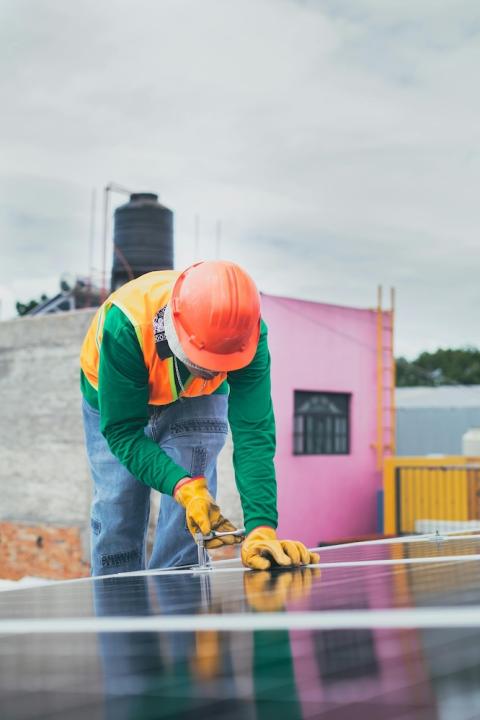
A truck carries annual supplies to the remote village of Padum in the Zanskar region of northern India. Across the country, road freight is the predominant mode of goods movement. (Image: Prabhu B Doss/Flickr)
When it comes to road freight, India is leading the way among emerging markets in accelerating the number of zero-emissions vehicles (ZEV) on the road. And it’s offering a blueprint for others to follow.
Increasing investments along the ZEV value chain in India is the aim of a unique public-private collaboration, the Zero-Emission Vehicles in Emerging Markets Initiative (ZEV-EMI), a model now being replicated in Mexico and other emerging markets.
The pace of decarbonization must accelerate in the face of worsening climate change. Transport is often at the top of sectors that need to do more, and for good reason: Transport accounts for close to a quarter of global energy-related carbon dioxide emissions.
To align with the Paris Agreement, and limit global warming to 1.5 degrees Celsius, 60 percent of global light-duty vehicle sales, 30 to 35 percent of zero-emission truck sales, and 60 percent of zero-emission buses must be electric by 2030, according to the International Energy Agency’s Global EV Outlook 2023. A zero-emission vehicle is any vehicle that emits no harmful pollutants at all from its exhaust pipe. A battery electric vehicle (BEV) is the most common type of ZEV.
Transport is undergoing fundamental transformation to meet the demands of a low-carbon world. But there are significant barriers to decarbonization, including uncertainty around technology deployment roadmaps, supply and demand for zero-emissions vehicles (ZEV) which hampers development, production and adoption along with insufficient financing. These challenges are particularly pronounced in emerging markets.
Electric freight in India
In India, road freight is the predominant mode of goods movement. Despite being less than 3 percent of vehicles, road freight accounts for 64 percent of the nation’s diesel consumption and contributes to 34 percent of road transport emissions.
More than 30 companies have come together under the first phase of Zero-Emission Vehicles in Emerging Markets Initiative. The effort is led by the World Business Council for Sustainable Development (WBCSD) and the U.S. and U.K. governments under the ZEV Transition Council (ZEVTC), along with the Indian government's E-FAST (Electric Freight Accelerator for Sustainable Transport) initiative to advance the electrification of the truck market in India. Companies in the initiative have launched several pilot projects and signaled demand for more than 5,000 electric trucks in India by 2027 and around 7,700 by 2030.
While this represents only 0.20 percent of current truck demand in India, or 4 million trucks on the road in 2022, it provides an important demand signal for further market development. When a number of purchasers come together to pool demand, electric trucks can be produced at a larger scale and lower cost, leap-frogging the technology adoption curve.
The initiative has started to have important ripple effects. A number of shippers are already piloting electric trucks in 2024 and 2025, including Amazon, Aditya Birla- Ultratech, Maersk and JSW, among others. As part of E-FAST, several partners have joined forces toward further e-truck market development, with the ambition to deploy 15,000 trucks by 2030.
As a key enabler, the initiative is also working collectively to accelerate the deployment of charging infrastructure corridors by de-risking infrastructure planning and related investments through data-sharing.
The companies have agreed to work together to deploy electric trucks through a national task force that will stimulate the development of the electric freight market in India. The task force is structured according to a national three-pillar strategy for electrifying trucks, including collecting and aggregating demand across shippers, shaping financing mechanisms for de-risking private investments, and enabling a favorable policy environment.
The incentive for action among the companies is clear, as this contributes to carbon emission reductions in their fleet operations as part of their own decarbonization commitments.
A game-changing approach
The ZEV-EMI initiative is a leading example of the collaboration needed to solve the climate crisis, in that it brings together all the essential actors to deliver real change. In Mexico, where the model is already being replicated, demand is already being collected across fleet operators. This includes trucks, cars and EV infrastructure, demonstrating the usefulness of the India model across different technologies and sectors.
As a multi-stakeholder, co-investment approach, the initiative is a win-win proposition. Companies with a shared strategic benefit can leverage their own investments together with funding from governments and other partners to achieve the scale that no single company or even single country could accomplish on its own.
A key part of what makes the collaboration so successful is that the companies engaged represent the entire value chain, from those who produce goods to those who ship goods and materials. Another critical success factor is the commitment of India’s government to decarbonize its road freight.
With the help of its partners, India is able to accelerate the pace at which it makes that happen. This is the kind of innovative space for collaboration that WBCSD can uniquely cultivate, representing multiple sectors and value chains that can bring a broad perspective to bear on solutions to complex challenges.
Once it all comes together, there is the opportunity to move quickly as demonstrated in India.
A blueprint for emerging markets
Other emerging markets can replicate this approach. Already the ZEV-EMI coalition is coordinating efforts to support Mexico’s zero-emission vehicle transition. The ongoing efforts focus on channeling investments along U.S.-Mexico infrastructure corridors and in urban fleet uptake by replicating the validated India e-truck market creation model.
This blueprint centers on five key elements of best practice: high-level, public-private dialogues to set shared priorities; bringing together purchasers to pool demand for market uptake; optimizing infrastructure investments through digital collaboration; coordinating with the finance community to create bankable projects; and demand-driven capacity-building.
Initiatives such as those led by ZEV-EMI in India help bridge the gap for emerging and developing markets to accelerate electrification of the transport sector, invest in the necessary infrastructure and ensure a resilient global e-mobility supply chain. This level of innovation and action will be critical in the years ahead if we are to shape a sustainable future in transportation.

Ms Diane B. Holdorf is Executive Vice President (EVP) and a member of the Senior Management Team (SMT) at the World Business Council for Sustainable Development (WBCSD), based in Geneva, Switzerland. Diane joined WBCSD in December 2018 as Managing Director of Food and Nature where she led business efforts to accelerate the system transformation in the areas of food, nature and water. In October 2021, Diane took the role of EVP for Pathways. In her role as EVP, Diane focuses on the Pathways as part of WBCSD’s strategy, leading business efforts to accelerate collaborative solutions in Food and Agriculture, Energy, Products & Materials, Mobility and Built Environment, and Health and Wellbeing – working in partnership to deliver business solutions for the Imperatives and Redefining Value Program pillars.














